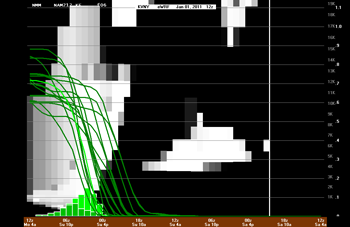

WRF Ensembles Projected Precipitation
Through Monday, January 3, 2011 at 4:00 a.m.
Up until a couple of days ago it looked like there might be some damp weather for the Rose Parade and even a better chance for the Rose Bowl game. An upper level low was the culprit, and they are notoriously difficult to model and forecast. The low is out there, it's just further to the north, and so is the rain.
How likely is rain on New Year's Day in Pasadena? Here's a plot generated on the Western Regional Climate Center web site, that shows the probability of various amounts of rain in a 1-day period at Pasadena. The probability of measurable rain (0.01 inch) in a 24 hour period around January 1 is about 20%, or about 1 in 5. As the rainfall amounts increase, the probability drops. The chance of 1.0 inch of rain is about 4%, or 1 in 25. Keep in mind that the probabilities indicated are for a 24 hour period. The chance of rain for the relatively short two hour duration of the Rose Parade is quite a bit less -- as history demonstrates.
Wednesday's cold front, the latest in our series of surprisingly frequent December weather systems, upped the water year rainfall total at Downtown Los Angeles (USC) to 11.70 inches. As of December 31, L.A.'s rainfall total is about 8 inches above normal, and more than three times the normal amount of rainfall for the water year to date. For the first six months of the 2010-11 water year, the rainfall total for Downtown Los Angeles is the fourth wettest in the 133 years that records have been kept. The water year starts on July 1 and ends June 30.
And we're not done yet. In a normal year, Downtown Los Angeles records about two-thirds of its annual rainfall in the months of January, February and March. This amounts to a little over 10 inches of rain. Depending on how you look at the data, rainfall for Downtown Los Angeles during a La Nina episode is usually about 70%-80% of normal. In addition, the composite plus trend plot for Jan-Feb-Mar precipitation anomaly (from CPC) is particularly dry in coastal Southern California, indicating negative anomalies in excess of 3 inches, with a high frequency of occurrence. Even so, it looks like Los Angeles has a good chance of exceeding the normal amount of annual rainfall of 15.14 inches. All we need before June 30 is another 3.45 inches!
The upper level low postponed on account of the Rose Parade, but due in tomorrow, should help with that. BUFKIT analysis of this morning's WRF ensembles projects anywhere from 0.6 inch to 0.9 inch of rain at Van Nuys through early Monday morning. The 18z NAM isn't as wet, projecting about 0.4 inch. The models are still having difficulties with the forecast, and slight changes in the position and behavior of the upper low could have a significant impact on the amount of rainfall. We'll see!
More information concerning Southern California weather can be found using our WEATHER LINKS page.